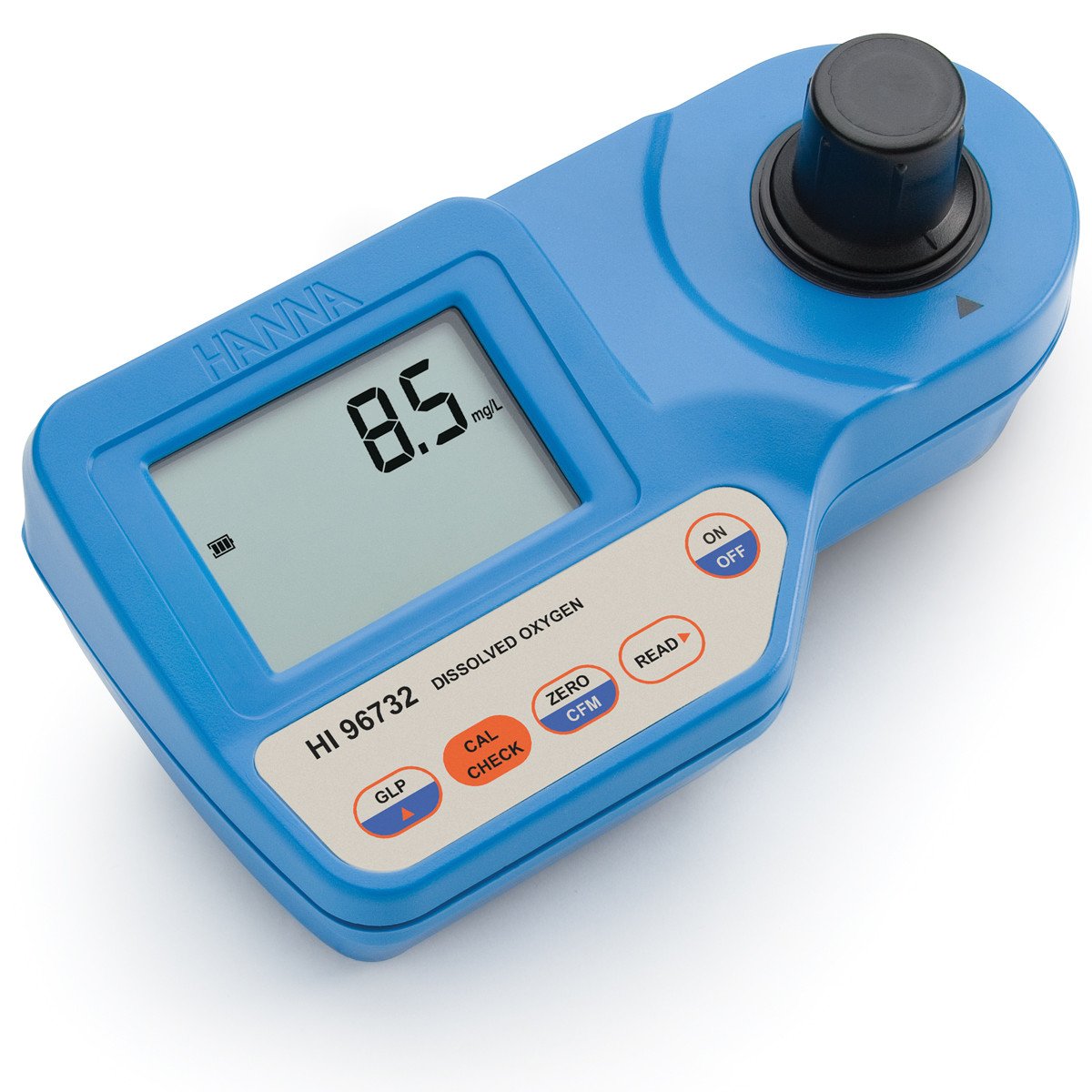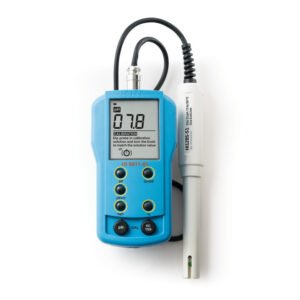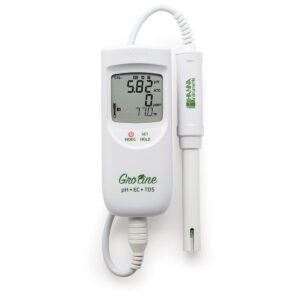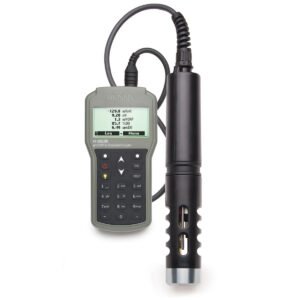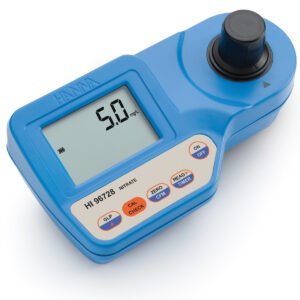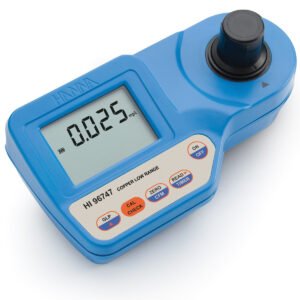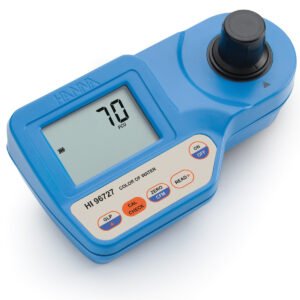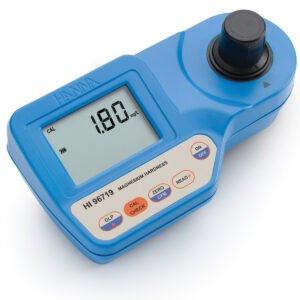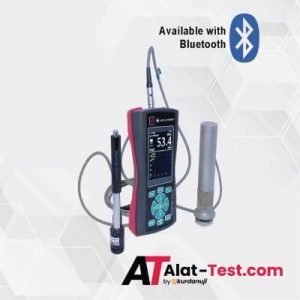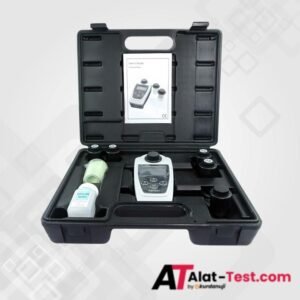The HI96732 portable photometer is for the measurement of dissolved oxygen. Hanna’s portable photometers feature an advanced optical system; the combination of a light emitting diode (LED), a narrow band interference filter, and silicon photodetector ensure accurate photometric readings every time. The Hanna exclusive CAL Check™ feature utilizes ready-made, NIST traceable standards to verify both meter validation and calibration. The exclusive cuvette locking system ensures that the cuvette is inserted into the measurement cell in the same position every time to maintain a consistent path length.
Features at-a-glance
CAL Check™ – Allows for performance verification and calibration of the meter using a CAL Check NIST traceable secondary standard.
GLP – Records the date of the last user calibration performed.
Built in timer – Ensures the appropriate reaction time is used for the chemical reaction. At the end of the timer the meter will automatically take the reading. This feature ensures consistency across multiple users.
Indexing indent on meter – The meter has an indent that allows for a lock and key fit with the cuvette cap. This ensures that the cuvette is indexed consistently (same position) in order to maintain the same path length for accurate results.
Cooling Lamp Indicator – It is necessary to maintain a consistent temperature of the optical components in order to maintain a narrow wavelength band of light. This photometer has a cooling lamp indicator that is displayed for a short period of time before each measurement in order to allow the components to cool and obtain the highest accuracy possible.
Error messages – Messages on display alerting to problems including no cap, over range and under range readings, and light source error.
Auto-shut off – Automatic shut off after 10 minutes of non-use when the meter is in measurement mode. Prevents wastage of batteries in the event the meter is accidentally not turned off.
Battery status indicator
The instrument has a battery level indicator to display remaining life as follows:
- 3 lines for 100 % capacity
- 2 lines for 66 % capacity
- 1 line for 33 % capacity
- Battery icon blinks when the capacity is less than 10 %.
Units of measure – Appropriate unit of measure is displayed along with reading.

Dissolved oxygen analysis measures the amount of gaseous oxygen (O2) dissolved in an aqueous solution. Dissolved oxygen is one of the most important parameters in aquatic systems. This gas is required for metabolism by aerobic organisms and also influences inorganic chemical reactions. Therefore, knowledge of the solubility and dynamics of oxygen distribution is essential to interpreting both biological and chemical processes within water bodies. Oxygen gets into water by diffusion from the surrounding air by aeration (rapid movement) and as a product of photosynthesis. The amount of oxygen (or any gas) that can dissolve in pure water (saturation point) is inversely proportional to the temperature of the water; the warmer the water, the less dissolved oxygen is present.
In aquaculture, dissolved oxygen is arguably the most important parameter of water quality. Most species require a minimum of 3 mg/L (ppm) dissolved oxygen, but 8 to 10 mg/L (ppm) is preferable. Unlike other gases such as nitrogen, oxygen supersaturation doesn’t usually result in gas bubble disease (“popeye”), so high levels generally aren’t an issue.
The HI96732 uses an adaptation of the Standard Methods for Examination of Water and Wastewater (18th edition) azide modified Winkler method to measure dissolved oxygen concentrations of less than 10.0 mg/L (ppm). When the reagent is added to a sample containing dissolved oxygen, the sample will turn a yellow hue; the greater the concentration, the deeper the color. The associated color change is then colorimetrically analyzed according to the Beer-Lambert Law. This principle states that light is absorbed by a complementary color, and the emitted radiation is dependent upon concentration. For dissolved oxygen determination, a narrow band interference filter at 466 nm (blue) allows only blue light to be detected by the silicon photodetector and omits all other visible light emitted from the LED lamp. As the change in color of the reacted sample increases, absorbance of the specific wavelength of light also increases, while transmittance decreases.

CAL Check™ standards with certificate
The HI96732-11 CAL Check™ standards are used for calibration and performance verification of photometers with the CAL Check™ function.
Supplied with Certificate of Analysis
- Lot number
- Expiration date
- Standard value @ 25 °C
- Reference meter NIST traceable
Provided storage containers
- Light tight
- Protects from accidental breakage

